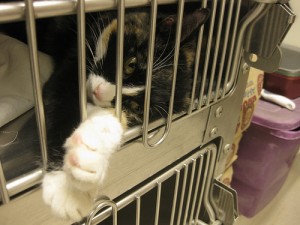Bringing Your New Cat Home
Congratulations! You are the proud new owner of a cat. No doubt you’re looking forward to years and years of happy companionship. But what do you do now?
The first thing you should know about your new pet is that most cats hate to travel. After the ride home from the animal shelter, he will, most likely, not be in the mood for fun. For the trip home, confine your pet in a sturdy cat carrier. Don’t leave him loose in your car where he might panic and cause an accident.
To make his transition to your household as comfortable as possible, select a quiet, closed-in area such as your bedroom or a small room away from the main foot traffic, and provide him with a litter box. Let your new pet become acquainted with that limited area for the first few days. Let him sniff all your belongings and investigate all the hiding places. Over a few days, slowly introduce him to the rest of your house, including the other pets and household members. It will take a little while, but he will eventually begin to feel at home.
Cats vary in terms of how demanding they are as pets, so let yours guide you to the level of attention he wants, whether it’s your hand for petting or your lap for sitting. Provide him with the necessary creature comforts and give him the companionship he seeks, and he will be content.
The following is a mini-primer of cats’ requirements for a happy life:

Pacino
Cleanliness.
Your new cat will prize a clean environment and a clean body. Cats are naturally fastidious and most will instinctively use a litter box; for some, you may need to place the cat in the box and make little scratching motions with their front paws so they get the idea. Many place such a premium on cleanliness that you should clean the box daily or several times a week. Cats also value privacy, so place the litter box in a convenient but secluded spot.
Most cats will spend hours grooming themselves, but even the most avid groomer can use a little help from time to time. Nail clipping and ear and teeth cleaning are tasks you can do to keep your cat well groomed. Even short-haired cats benefit from weekly brushing, a task that can be pleasurable for both of you.
Security.
Provide your cat with safety and security. Always use a cat carrier when transporting your pet. Protect him by making certain that all windows are securely screened, and that the washer and dryer are kept closed and are inspected before each use. Get into the habit of ensuring that drawers, closets, and cupboards are uninhabited before you close them. And for your own security, put a collar and tag on your feline—there’s always the chance he may slip outside by mistake, and you want to make sure he can be identified as your pet.
Health Care.
Animal shelters take in animals with widely varying backgrounds, some of whom have not been previously vaccinated. Despite the best efforts of shelter workers, viruses can spread and may occasionally go home with adopted animals. If you already have dogs or cats at home, make sure they are up-to-date on their shots—including feline leukemia—and in good general health before introducing your new cat.
Take your new cat to the veterinarian within a week after adoption. There, he will receive a health check and any needed vaccinations. If your cat has not been spayed or neutered, make that appointment! There are already far too many unwanted kittens and cats; don’t let your new pet add to the problem. Most likely, the shelter will require that you have your pet spayed or neutered anyway. If you need more information about why it is important to spay or neuter your cat, read our online information on spaying and neutering.
House Rules.
Provide your cat with some “basic training” to help him get along in your home. It’s true that cats usually have their own ideas about how to do things. Even so, most cats can be taught to obey simple rules like not scratching the couch, eating plants, or jumping up on the kitchen counter. With repeated, gentle, and consistent training, your cat will learn.
Yelling at your cat never works. Instead, positively reward him and provide him with alternative choices. A good scratching post—coupled with the handy squirt gun filled with water—can save your couch, your chair, and your nerves. If you help your cat understand the rules and give him a satisfying outlet for his scratching impulses, there will be no need to have him declawed, an unnecessary operation no cat should endure.
Room for Fun.
Finally, provide your cat with an interesting indoor environment. Cats love to play and will appreciate simple and inexpensive toys. Ping-Pong balls and paper bags can provide hours of fun. A comfortable perch by a window can become your cat’s very own entertainment and relaxation center.
Toys are very important for cats. They not only fight boredom, they also give cats a chance to express their prey-chasing drives. If you’re the one moving the toy while your cat chases after it, playtime can be a bonding experience for both of you.
Enjoy Your Rewards.
Now that you’ve made certain all the basic provisions are attended to, you can relax and enjoy your new pet. It may take a couple of weeks for him to adjust to life with you. But before you know it, you’ll be curled up on the couch together, watching TV like old pals, and you won’t remember what life was like without him.
Reprinted by permission of
The Humane Society of the United States.
How to Choose the Right Dog
You might think that deciding whether to adopt a dog or not is the toughest part. However, wait till you get to the shelter! With so many little adorable four-legged fur-balls and puppy-eyes around, you just won’t know which one to take home! They come in so many shapes and sizes and each of them has one adorability factor or another and it can just get to be too much. You have to understand that if you don’t know how to choose the right dog there will be problems down the line.
It would be really unfair, incorrect actually, to say that one breed is better than other, especially in a shelter, where any one of the dogs could be a treasure. What is actually of essence is to see which dog would be better for your specific situation, needs and limitations. Therefore, the following points might help:
1. Understand your limitations
Understanding your constraints as an owner is the first step. This is more important than deciding which dog looks cutest. Let’s say you live in condo or an apartment, in which case you would want a dog that is small and can do without much daily exercise. If you have a large house with a backyard, then almost any breed will work fine. Think about your time commitments, the other members of the household, even your social life will decide which personality, breed and size will work for you.
2. Learn about different breeds

Chuck and Terry
The breed of the dog considerably influences his or her personality, behavioral traits and physiology – and you need one that matches your considerations. Essentially there are two basic classifications: pure breeds and mixed breeds. Purebred dogs come from a family of same breeds and thus it is easier to know for sure what traits he will display and what his health might be like. With a mixed breed, the parental lineage could include just about any dog. These breeds tend to be genetically more sound, and often show very good health when cared for well. Also, you get the qualities of various dogs in one. Of course some people prefer pure breeds for the certain snob value they hold, but after all, it’s all about who wins your heart.
3. Visit the shelter
Once you have some idea about the different breeds, a visit to the shelter will prove beneficial. Now, a shelter is not exactly the best place for a dog and most of the time the dog will not be himself. Therefore first impressions could be wrong. It is good to have an adoption counselor by your side as you walk through or a volunteer who might be able to give you a better insight into the dog’s personality and help you make a decision. Insist on spending sometime alone with a few dogs that you might like and consider the following:
Age: A younger puppy is usually desired since it is easier to habituate a pup to your home and lifestyle. However, puppies also require some training – especially toilet training and general obedience training. Older dogs, on the other hand, are already trained by their owners which would be saving you some effort. However, they might also posses certain habits that don’t go down well with you and it’s hard to change that with older dogs. Decide depending on your lifestyle.
Size: Think if you want to be able to take your pet along often, in which case you need a smaller kind. However, if you have young kids, the smaller dogs are not the most appropriate. Again, check your breed characteristics.
Personality: Dogs are usually shy and quiet or assertive and active. If you like some peace and quiet, then a terrier who barks his head off at any new thing may not be for you. But if you like jogging, running around parks or have active kids, then an active retriever will suit you just fine
Social disposition: Depending on their past experiences with people, certain dogs are very picky about social interaction. They will just not let anyone but their owner touch them and could turn quite hostile if someone intrudes on their privacy. Therefore, try to find out a little about the dog’s background to avoid any unpleasant surprises. Most dogs however, tend to be social and very friendly. Take a look at the dog’s history and discuss his general behavior with the counselor or volunteers and you will have an idea how good he is with people.
Usually, if a dog’s previous owners were unkind to him, or even violent, the dog might be untrusting of all people. Although such dogs deserve love and care as well, it’s up to you to decide if you are in a situation to provide it with the patience that it requires.
A dog will be your best friend for life!
A dog suited to your personality and lifestyle can bring you great joy and fun, and a wrong decision might bring you some inconveniences that shadow on the happy parts. Although all dogs can be your best friends, this is going to be more like a live-in relationship; so you need to be very sure of your compatibility. Trust me, breaking up with your dog can be very painful.
How to Choose the Right Cat
Cats and dogs are oh, so different, but , are they? One usually does not associate the words “faithful”, “companion” and “loyal” with cats. But if you’d like to have a great faithful and loyal companion, and you are not ready for a dog, a cat might be the right pet for you. True… you can’t take your cat to the park and spend the day throwing a ball, but cats can also be your best friends.
It’s not just a cat, it’s a whole new personality
When you are choosing a cat, personality is very important. While at the shelter different cats will behave differently: some like to get attention, some will not stop mewing, others will be loving and some will just observe you from a distance. You can judge a cat’s personality by the way it responds to your touch. Ask the volunteers or counselor for some time alone with the cat. Notice if the cat likes to be played with and is alert to your movements or just sits there and ignores you. Does it look at you or acts aloof? Try dragging a string around, or see if the cat rubs on your legs. However, not all cats may respond normally, since they might be scared of the shelter’s environment. If you happen to like a cat that’s too timid, try interacting with it over a couple of visits to see any change in temperament. Just make sure you get what you want. If you like cats, but are not very keen on having one rub against you or look to get on your lap all the time, an aloof, independent cat might be for you, but it can be frustrating for someone that is looking for a friend to cuddle and play with.
Cute kitten or grown cat?

Ginger, Spot and Goliath
Both have their advantages. With a kitten, there’s never a dull moment. They are full of energy and can keep you laughing and entertained with their little antics. However, they need to be cared for, trained and fed. You are going to have to be their momma for a while. Young kids usually don’t have the maturity to handle kittens responsibly, so a cat about four months old is the best choice for homes with children. A grown cat tends to be lazier and less mischievous, preferring to relax rather than chase a silly toy across the floor. An adult cat can fend for him or herself, so they can be left unsupervised without so much worry. An adult cat already developed its personality, so you will know what you’re getting. A kitten will be an adventure. A grown cat will probably be independent and set on its ways. A kitten will grow up with you and get used to your lifestyle.
Hair raising factors
Cats groom themselves, in fact, they spend hours doing so, and therefore, their hair is pretty much their own business. However, since it’s living in your house, you will want to decide what kind of hair you want your kittie to have. Short-haired cats are more common than long-haired ones, and you will find lot’s of these at the shelter. Long -haired cats require more grooming. Kittens are normally cleaned by their mothers for the first few months so you will have to play mommy and wipe them clean with a damp cloth. Thankfully, cats enjoy this practice and will very happily let you make all the effort.
Join the gang
If you have other pets at home – like a dog or another cat, then it’s very important that you introduce them to their new friend properly, lest the peace and tranquility of the house be disrupted. It usually takes some time for cats to get to know and like each other, and sometimes a little longer for dogs and cats. They can all happily live together and most of the times get along very well, but you have to start off on a safe note by giving the newcomer some room for her or himself till they’re habituated to the house, and the other pets, habituated to his or her presence. Eventually, you can let them spend some time with the rest of the lot, starting with short supervised intervals of time until they’re ready to be left alone. Be prepared to be patient.
Be responsible!
Cats are usually looked at as being low maintenance, however, they also come with their share of responsibilities for the owner. Cats have a tendency to roam about and don’t particularly mind leaving home. Do your best to keep your cat indoors from the very beginning. I’d recommend reading my article Good Reasons to Keep Your Cat Indoors. Spaying or neutering your cat will ensure that there are no new pregnancies to add to the millions of kittens born each year who are abandoned at shelters and never find a good home. Sapying and neutering also help cats live longer, healthier lives. You will need to take your cat to the vet regularly (especially when you get him or her home for the first time) and give it some exercise everyday to avoid health problems, especially weight issues. This can be easily done since most cats love to play.
Adopt a cat for life
Just keep in mind that although cats have this reputation of being “independent”, they love and appreciate company and attention as much as the next pet. You will be sharing your life with this being for many years. So choose responsibly and you will have a wonderful and fulfilling time with your new adopted pet.
Are You Really Ready to Adopt a Pet?
It always happens. Every time you see the picture of a cute little pup or furry little kitten, you ‘awww’ and ‘oooh’ and you just want one! You can’t help but pet each dog that comes your way while walking on the street and you bring tasty treats for your friend’s pets when you go visiting.
Every time a pup licks you or a cat rubs against your leg, you think it’s a sign telling you to get your own. But hold your horses! (or doggies, or kitties, as you might prefer). Adopting a pet is about a lot more than signs or gut feelings or even desires.
We’re not discounting desire as a factor in bringing home a pet – it is important – but there are other factors that are much more important. Many owners have fallen prey to the misconception that the ‘I-just-saw-him-and-fell-head-over-heels-in-love’ feeling will see them through the 15 odd years they will spend with their pets. Adopting a pet is quite a happy thought. However, it needs to be turned into reality. You need to give owning a pet a lot of thought.
The following points make it easier for you to judge if your decision is really sound, read it through and answer each point honestly to reach a conclusion.
What’s your reason for adopting?
Adopt for a reason that will last, since that will determine how healthy and enjoyable your relationship will be. Reasons like momentary loneliness, boredom, or curiosity might not be ideal, since these conditions will pass. You need a reason that will keep for many, many years to come.
Do you have time?
Having a pet in your house requires a good investment of time, and it can’t be put on a schedule of maybe one hour a day. When your pup is young, you will have to spend a lot of time with him, training him and getting him used to your home. When he falls sick, you’ll have to be by his side. And, you should give them this time gladly, not just out of obligation.
 Can you afford it?
Can you afford it?
Adopting doesn’t just involve the cost of adoption fees. Taking care of a pet comes along with a series of expenses – good food, grooming, hygiene, toys, changes to your house, regular vet visits, medication, and what not.
What is you lifestyle?
Do you live in a place where you can share space comfortably with a pet? If you live in a condo you might feel cramped and your neighbors or landlord might object. Also, if you work late nights, have a baby, travel a lot or have an erratic schedule, a pet might not fit well into your scheme of things.
What happens if something goes wrong?
 What if you get sick or you have to leave the pet alone? Do you have someone you can count on to help you out? Becoming solely responsible for another life is a big decision. You will need some kind of help (friends, relatives, friendly neighbors) or at least the financial means to hire such help.
What if you get sick or you have to leave the pet alone? Do you have someone you can count on to help you out? Becoming solely responsible for another life is a big decision. You will need some kind of help (friends, relatives, friendly neighbors) or at least the financial means to hire such help.
Will you commit?
The most important question: Do you think you can love, cherish and take care of your pet for as long as he lives? I repeat – as long as he lives. This is quite a responsibility. If you’re going to adopt a pet, you will need to promise yourself that you will take care of him to the best of your ability. And taking care of a pet is quite a task.
If most of these questions make you reconsider your decision, don’t lose heart. It’s all for the best. Visit any animal shelter and you will notice that most of the animals are there because their owners didn’t think of all these questions, got carried away by their feelings and took the animal home, only to realize a year later that they couldn’t handle it. It is a highly insensitive act – to willingly welcome someone into your home and then turn them out – especially someone as helpless and innocent as a poor little dog or cat.
All these factors are just as important if not more as what ‘kind’ of a pet you want to have. For instance, dogs require exercise, some, at least an hour every day. If you live in an apartment in the city and you don’t like to walk, this becomes unfeasible. Even a tiny and active little terrier is more suited with owners who have the time to give it exercise and play with it. But don’t think a cat is any easier… well it is, since you don’t have to walk them, but they do need play time, and attention, and although they have this reputation of being independent, they crave company and they need it to be healthy and happy.
Welcoming a pet into your house and your life can be one of the most enriching experiences you ever have. However, thinking it through is very important. When you bring a pet home, it’s just as having a baby – every decision you make thereon affects you and your pet in equal measure. It’s a living being who you will share a good part of your life with… but oh, what a fulfilling life it will be.
Top Five Reasons to Adopt a Pet
1. You’ll Save a Life
Sadly, between three and four million dogs and cats are euthanized each year in the United States simply because too many people give up their pets and too few people adopt from shelters. Because there is limited space at shelters, staff members sometimes need to make very hard decisions to euthanize animals who haven’t been adopted. But the number of euthanized animals could be reduced dramatically if more people adopted pets instead of buying them. By adopting from a private humane society or animal shelter, breed rescue group, or the local animal control agency, you’ll help save the lives of two animals—the pet you adopt and a homeless animal somewhere who can be rescued because of space you helped free up.
2. You’ll Get a Healthy Pet
Animal shelters are brimming with happy, healthy animals just waiting for someone to take them home. Most shelters examine and give vaccinations to animals when they arrive, and many spay or neuter them before being adopted. In addition to medical care, more and more shelters also screen animals for specific temperaments and behaviors to make sure each family finds the right pet for its lifestyle.
It is a common misconception that animals end up in shelters because they’ve been abused or done something “wrong”. In fact, most animals are given to shelters because of “people reasons,” not because of anything they’ve done. Things like a divorce, a move, lack of time or financial constraints are among the most common reasons why pets lose their homes.
3. You’ll Save Money
Adopting a pet from an animal shelter is much less expensive than buying a pet at a pet store or through other sources. In addition, animals from many shelters are already spayed or neutered and vaccinated, which makes the shelter’s fee a real bargain.
4. You’ll Feel Better
Pets have a way of putting a smile on your face and a spring in your step. Not only do animals give you unconditional love, but they have been shown to be psychologically, emotionally, and physically beneficial. Caring for a companion animal can provide a sense of purpose and fulfillment and lessen feelings of loneliness and isolation in all age groups.
Pets can help your physical health as well—just spending time with an animal can help lower a person’s blood pressure and cholesterol levels, and dog walking, pet grooming, and even petting provide increased physical activity that can help strengthen the heart, improve blood circulation, and slow the loss of bone tissue. Put simply, pets aren’t just good friends, they’re also good medicine and can improve a person’s well-being in many ways.
5. You Won’t Be Supporting Puppy Mills and Pet Stores
Puppy mills are “factory style” dog-breeding facilities that put profit above the welfare of dogs. Most dogs raised in puppy mills are housed in shockingly poor conditions with improper medical care, and the parents of the puppies are kept in cages to be bred over and over for years, without human companionship and with little hope of ever joining a family. And after they’re no longer profitable, breeding dogs are simply discarded—either killed, abandoned or sold at auction.
Puppy mill puppies are sold to unsuspecting consumers in pet stores, over the Internet and through newspaper classified advertisements to whoever is willing to pay for them. Marketed as coming from great breeders, well-rehearsed sales tactics keep money flowing to the puppy mill by ensuring that buyers never get to see where the pups actually come from (a vital step in puppy buying). Many of the puppies have serious behavioral and health problems that might not be apparent for months, including medical problems that can cost thousands of dollars to treat, if they are treatable at all. Unfortunately, a lot of people are not even aware that puppy mills exist, so when they buy a pet from a pet store, online or other retail outlet, they are unwittingly supporting this cruel industry.
By adopting instead of buying a pet, you can be certain you aren’t supporting cruel puppy mills with your money. Puppy mills will continue to operate until people stop purchasing their dogs. Instead of buying a dog, visit your local shelter where you will likely to find dozens of healthy, well-socialized puppies and adult dogs—including purebreds—just waiting for that special home—yours.
Updated Jan. 30, 2008.
“Reprinted by permission of
The Humane Society of the United States.”
Neutering or Spaying Your New Dog
If you are having doubts about neutering or spaying your new dog, you have to consider the benefits for his or her health and for both your lives.
Male dogs are not “manly” and female dogs do not “need” to have puppies.
There are people (usually men… no offense, guys) that actually think that keeping their dog’s testicles intact is manly, both for the dog and for the owner… sometimes, people go as far as to have prosthetic testicles inserted for their neutered dogs. To each it’s own, but… really?
Also, breeding a dog is not necessarily better for the animal, neither male nor female, and it certainly can make dogs much more difficult to manage if they are not neutered.
Unless there is a specific reason to breed your dog, it should be neutered or spayed at an early age to prevent pregnancies, avoid aggressive male behavior, and even lessening the possibilities of some forms of cancer.
It’s normally recommended that the dog gets neutered between 2 and 6 months old. Of course, there is always a small risk associated with any sort of surgery, but it’s riskier to own a dog with an aggressive sex drive. Another reason to do it early, is that younger pups manage through the surgery option much better than older dogs. The surgery is very simple and can be performed in a matter of minutes.
Now, let’s clarify some myths:
Early neutering or spaying does not stunt growth. That’s a myth propagated by breeders and others who don’t want to spay their animals.
Your dog will not get fat and lazy after being spayed or neutered unless you feed him/her too much.
What happens if your male dog is not neutered?
-They will pee on everything they find on their way: furniture, curtains, shoes, clothes, walls… you get the idea.
-Dogs might be aggressive to other dogs and also hump even other male dogs. Just this fact should give you an idea of what kind of aggression can develop in those circumstances, besides, it’s very embarrassing.
-Even dogs that normally have the most wonderful temperament, can get aggressive towards humans and other dogs. A male will actually attempt to kill any male who he thinks will mate a bitch near him.
Don’t be kind to your dog by “letting try it out at least once”. Once a dog has actually had sex, his behavior can be magnified significantly when coming in contact with fertile bitches.
When a male dog is after a fertile female, breeding is the only thing on his mind. He will do anything that he can think of to get to her: scaling fences, breaking down doors, mating through fences, digging, etc. Besides risking getting sued for any damage, another thing to consider is that you are as responsible as the owner of the female for any puppies that are born.
What happens if your female dog is not spayed?

Rovespierre
-First, you can count on having her locked up twice a year to keep her away from all those dogs that I mentioned before.
-Her risk of mammary cancer doubles, although it doubles from almost nothing to very low with only one heat, it climbs quickly thereafter till after 5 heats as it starts to approach 50%. Be very careful that you don’t allow a mating when she gets her first heat because this can be life threatening. It is very important to spay her before the first heat.
-A brother and sister from the same litter can create their own litters by the age of five months. It is not a good idea to allow this to happen.
-Male dogs can sometimes be quite aggressive to a female in season.
-Your house will be a mess, and her behavior will drive you crazy.
After reading all this, you need to ask yourself, “is it really worth it?”
Frankly, in the 99.99% of cases, it is not.
Don’t wait until your dog starts getting sexual drives before you neuter him. In many cases, once the dog starts the misbehavior associated with attempting to breed, that behavior can stay even after the neutering has taken place.
Do yourself, your family, your neighbors and your beloved dogs a favor by getting them spayed and neutered.
Bringing a New Puppy Home
You got your new puppy almost a week ago. Since then, the little angel has eaten your favorite shoes, two of your favorite novels, gnawed the trim around every doorway, chewed through the power cord of your computer and this morning he found boxes and boxes of kleenex in your bathroom… what a mess! This is getting really expensive and it’s starting to get very dangerous for the puppy also. Maybe you should do something.
What do you do?
You need to understand that chewing is a normal and healthy part of any pup’s development, but they should know what to chew, right? Puppies are like human children, they learn about their world through chewing. They use their senses to explore the new world, and their tactile sense and sense of taste is brought into play as they chew on various objects.
Like human children, pups need our protection from the dangers of the dangers that lurk in their explorations.
Everything from needles, electrical cords, houseplants and household chemicals, to chocolate and raisins, all pose very real threats to your pet. It is your duty to protect her from these threats.
You have to be very consistent training him with the “NO” command. You puppy should learn and respond to the word “No” instantly. This one word has saved many dogs from horrible fates. The puppy is trained by using the “NO” command every time a situation occurs. If you catch your pet chewing on your shoes, say “NO” in a serious tone, not screaming, not angry, and take the item from him or her. Don’t let it become a tug-o-war. Just remove the item quickly and give him a suitable toy. Also, try not to chase him when he has the object in his mouth or he’ll think it’s a game.

Lady Pee
When I bring a puppy home, I like to use one of my unwashed pillow cases, and put a lot of different toys with different textures (hard plastic, cloth, soft plastic, rubber, etc.) in it. Then I choose one toy of each textures, and those are his toys for the day. That way he doesn’t get bored, and since the toys have my scent, it helps the bonding process as well.
Another thing I do is buy marrow bones and boil them just a few minutes just enough to get the marrow out. Then I wrap them in foil and freeze them. This serves two purposes: one, it keeps him entertained and happy for hours, specially if I give it to him just before I leave. And two, the frozen bone alleviates the pain of his growing teeth, so he’ll be grateful. Just be careful never to boil the bones more than 4 or 5 minutes, and never give him any other kind of bone! You can give him raw-hide bones, but not too many, just once in a while. Pieces of ice are also a good idea. My dogs have always loved to chew on those!
With these simple suggestions, you can insure your puppy’s good health and the well being of many, many shoes.
Control Your Dog’s Excited Urination
Who has not come across a dog that pees on cue as soon as you approach him or her to greet them? This is what is called submissive or excited urination
What is submissive or excited urination and why does it happen?
A submissive urinator is a dog that cannot help urinating in situations of extreme excitement or stress – he’ll go on the floor, on himself on you, on your furniture or on your guests!
Puppies are a perfect example of submissive urinators. They’ll pee whenever they’re excited to see you or when they meet a stranger. But sometimes very timid or sensitive adult dogs can have the problem too. It’s very typical of a dog that has been abused to exhibit this behavior.
This problem can happen in many situations:
-When they meet you after a prolonged absence
-When they’re playing
-When your guests arrive
-When there’s a stressful situation at home
-When you scold him or correct him
-Loud noises like a thunderstorm or fireworks
But don’t despair. It is really not difficult to fix this problem of submissive/excited urination.
First of all, take him to the veterinarian to make sure there’s no medical reason for the issue. Diabetes or a bladder infection can have the same effect.
Then you can follow some simple steps:
-Limit his intake of water. This doesn’t mean that you should restrict his water intake, but if, for example, you are expecting guests, or you will soon have a play session, take his water bowl away for a little while before the event happens.
-Don’t make your coming home a big event. When you come in the door, ignore him, go about your business and don’t get him worked up. The more excited he is, the harder it will be for him to control his bladder. I know I have a hard time not saying a warm hello to my baby, but you can always ignore him for the first few seconds and then crouch down and greet him calmly.
-Keep in mind the importance of NOT punishing or yelling at your dog when he has his “accident”. Remember he cannot control it and above all, he’s not doing it on purpose. When you catch him in the act, interrupt him with a firm “No!”, and praise him when he stops, but never punish him. Keep calm and be understanding: he doesn’t mean to do it.
-When he urinates out of fear (submissiveness) when you are scolding him for another reason, try to maintain an authoritative and firm tone, but don’t get angry. Keep in mind that in all probability, you are dealing with a sensitive, highly-strung dog, so, if you get angry or worry him further, the problem will definitely get worse.
-When the problem happens with loud noises like fireworks, if you show a reaction yourself and pet him for being scared, you will only be rewarding the behavior and training him to repeat it, and you don’t want that. You can try and make it a game. When you hear a loud bang, say, “what was that!” Make it a search game and give him a treat or a toy. You can also make no reaction whatsoever, or fuss or comfort him. Give him the down and stay commands, give him a treat and tell him he’s a good boy.
Always remember that when you have a dog, you must treat him with respect and understanding. Almost every “problem” has a solution, and with a little patience, you can do it without the need of expensive training. A few hours working on a problem, can give you many years of enjoyment with your best friend.
I Rescued a Human Today

Her eyes met mine as she walked down the corridor peering apprehensively into the kennels. I felt her need instantly and knew I had to help her. I wagged my tail, not too exuberantly, so she wouldn’t be afraid.
As she stopped at my kennel I blocked her view from a little accident I had in the back of my cage. I didn’t want her to know that I hadn’t been walked today. Sometimes the shelter keepers get too busy and I didn’t want her to think poorly of them.
As she read my kennel card I hoped that she wouldn’t feel sad about my past. I only have the future to look forward to and want to make a difference in someone’s life.
She got down on her knees and made little kissy sounds at me. I shoved my shoulder and side of my head up against the bars to comfort her. Gentle fingertips caressed my neck; she was desperate for companionship.
A tear fell down her cheek and I raised my paw to assure her that all would be well. Soon my kennel door opened and her smile was so bright that I instantly jumped into her arms. I would promise to keep her safe. I would promise to always be by her side. I would promise to do everything I could to see that radiant smile and sparkle in her eyes.
I was so fortunate that she came down my corridor. So many more are out there who haven’t walked the corridors. So many more to be saved. At least I could save one.
![]()
. . . By Janine Allen
Adopting from an Animal Shelter
Animal shelters from your local Humane Society are your best source when looking for a cat or a dog to bring into your family. Not only do they have a great selection of adult animals for adoption, but they also have kittens and puppies, even purebred animals. On average, purebreds account for about 25 to 30 percent of a shelter’s dog population. So before you look for a dog or a cat for sale, go to the American Humane Society, and take the steps to adopt a dog, or a cat that really needs a home.
Many pets at your local shelter are waiting for new homes because they were obtained by someone with unrealistic expectations of the time, effort, and money required to sustain a lifelong relationship with their pet. National figures indicate that about half of the animals in shelters must be euthanized for lack of homes. Animals at your local shelter are eager to find a new home and are just waiting for someone like you.
You can depend on responsible shelters to assess the animals’ health and temperament in order to make the best adoption matches possible. When animals are relinquished by owners, the shelter staff makes every attempt to collect a thorough history of that pet. Then, while caring for animals, staff and volunteers try to learn as much as they can about these animals as well as those who come to the shelter as strays.
Don’t be discouraged if, when you first visit the shelter, there are no animals of the breed or type you want. Shelters receive new animals every day.
 Your shelter may also have a waiting list and can call you when an animal matching your preference becomes
Your shelter may also have a waiting list and can call you when an animal matching your preference becomes  available. Before choosing your pet, you can even speak with an adoption counselor about whether your choice of a particular type or breed will be best for you. In an effort to make good matches between people and animals and to place pets in lifelong homes, many shelters provide adoption counseling and follow-up assistance, such as pet parenting and dog-training classes, medical services, and behavior counseling. Or they may be able to refer you to providers of these services.
available. Before choosing your pet, you can even speak with an adoption counselor about whether your choice of a particular type or breed will be best for you. In an effort to make good matches between people and animals and to place pets in lifelong homes, many shelters provide adoption counseling and follow-up assistance, such as pet parenting and dog-training classes, medical services, and behavior counseling. Or they may be able to refer you to providers of these services.
Another advantage is that shelter adoption fees are usually much less than an animal’s purchase price at a pet store or breeder. And your new pet is more likely to be vaccinated, dewormed, and spayed or neutered.
To locate your local animal shelter, check the Yellow Pages under “animal shelter,” “animal control,” or “humane society.” Many shelters have websites on which they display the animals they have available for adoption. Some sites allow you to download adoption forms and read about responsible pet care. |
A growing number of shelters also promote their web sites, and the animals they have for adoption, on sites such as Pets 911, Petfinder, and 1-800-Save-A-Pet.com.
Reprinted by permission of The Humane Society of the United States



